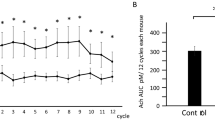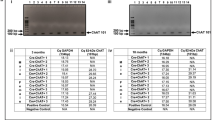Abstract
Basal forebrain cholinergic neurons (BFCNs) degenerate in aging and Alzheimer’s disease. It has been proposed that estrogen can affect the survival and function of BFCNs. This study characterized primary rat BFCN cultures and investigated the effect of estrogen on high-affinity choline uptake (HACU). BFCNs were identified by immunoreactivity to the vesicular acetylcholine transporter (VAChT) and represented up to 5% of total cells. HACU was measured in living BFCN cultures and differentiated from low-affinity choline uptake by hemicholinium-3 (HC-3) inhibition. A HC-3 concentration curve showed that 0.3 μM HC-3, but not higher concentrations that inhibit LACU, could distinguish the two transport activities. 17-β-Estradiol treatment increased HACU in some culture preparations that contained non-neuronal cells. Elimination of dividing cells using antimitotic treatments resulted in a lack of estrogen effects on HACU. These results suggest that estrogen may have indirect effects on BFCNs that are mediated through non-neuronal cells.







Similar content being viewed by others
Abbreviations
- AD:
-
Alzheimer’s disease
- BFCNs:
-
Basal forebrain cholinergic neurons
- ChAT:
-
Choline acetyltransferase
- HACU:
-
High-affinity choline uptake
- HC-3:
-
Hemicholinium-3
- LACU:
-
Low-affinity choline uptake
- NGF:
-
Nerve growth factor
- VAChT:
-
Vesicular acetylcholine transporter
- VAChT-IR:
-
VAChT-immunoreactive
References
Gustilo MC, Markowska AL, Breckler SJ et al (1999) Evidence that nerve growth factor influences recent memory through structural changes in septohippocampal cholinergic neurons. J Comp Neurol 405:491–507
Baxter MG, Chiba AA (1999) Cognitive functions of the basal forebrain. Curr Opin Neurobiol 9:178–183
Bartus RT (2000) On neurodegenerative diseases, models, and treatment strategies: lessons learned and lessons forgotten a generation following the cholinergic hypothesis. Exp Neurol 163:495–529
Sofroniew MV, Cooper JD, Svendsen CN et al (1993) Atrophy but not death of adult septal cholinergic neurons after ablation of target capacity to produce mRNAs for NGF, BDNF, and NT3. J Neurosci 13:5263–5276
Coyle JT, Price DL, DeLong MR (1983) Alzheimer’s disease: a disorder of cortical cholinergic innervation. Science 219:1184–1190
Henderson VW (1997) Estrogen, cognition, and a woman’s risk of Alzheimer’s disease. Am J Med 103:11S–18S
Miettinen RA, Kalesnykas G, Koivisto EH (2002) Estimation of the total number of cholinergic neurons containing estrogen receptor-alpha in the rat basal forebrain. J Histochem Cytochem 50:891–902
Toran-Allerand CD, Miranda RC, Bentham WD et al (1992) Estrogen receptors colocalize with low-affinity nerve growth factor receptors in cholinergic neurons of the basal forebrain. Proc Natl Acad Sci USA 89:4668–4672
Shughrue PJ, Scrimo PJ, Merchenthaler I (2000) Estrogen binding and estrogen receptor characterization (ERalpha and ERbeta) in the cholinergic neurons of the rat basal forebrain. Neuroscience 96(1):41–49
Kawas C, Resnick S, Morrison A et al (1997) A prospective study of estrogen replacement therapy and the risk of developing Alzheimer’s disease: the Baltimore Longitudinal Study of Aging. Neurology 48:1517–1521
Gibbs RB (2000) Effects of gonadal hormone replacement on measures of basal forebrain cholinergic function. Neuroscience 101:931–938
Zandi PP, Carlson MC, Plassman BL et al (2002) Hormone replacement therapy and incidence of Alzheimer disease in older women: the Cache County Study. JAMA 288:2123–2129
Waring SC, Rocca WA, Petersen RC et al (1999) Postmenopausal estrogen replacement therapy and risk of AD: a population-based study. Neurology 52:965–970
Tang MX, Jacobs D, Stern Y et al (1996) Effect of oestrogen during menopause on risk and age at onset of Alzheimer’s disease. Lancet 348:429–432
Yaffe K, Lui LY, Grady D et al (2000) Cognitive decline in women in relation to non-protein bound oestradiol concentrations. Lancet 356:708–712
Mulnard RA, Cotman CW, Kawas C et al (2000) Estrogen replacement therapy for treatment of mild to moderate Alzheimer disease: a randomized controlled trial. Alzheimer’s Disease Cooperative Study. JAMA 283:1007–1015
Shumaker SA, Legault C, Kuller L et al (2004) Conjugated equine estrogens and incidence of probable dementia and mild cognitive impairment in postmenopausal women: Women’s Health Initiative Memory Study. JAMA 291:2947–2958
Geerlings MI, Launer LJ, de Jong FH et al (2003) Endogenous estradiol and risk of dementia in women and men: the Rotterdam Study. Ann Neurol 53:607–615
Jope RS (1979) High affinity choline transport and acetylCoA production in brain and their roles in the regulation of acetylcholine synthesis. Brain Res 180:313–344
Apparsundaram S, Ferguson SM, George AL Jr, Blakely RD (2000) Molecular cloning of a human, hemicholinium-3-sensitive choline transporter. Biochem Biophys Res Commun 276:862–867
Pongrac JL, Gibbs RB, Defranco DB (2004) Estrogen-mediated regulation of cholinergic expression in basal forebrain neurons requires extracellular-signal-regulated kinase activity. Neuroscience 124:809–816
Dominguez R, Jalali C, de Lacalle S (2004) Morphological effects of estrogen on cholinergic neurons in vitro involves activation of extracellular signal-regulated kinases. J Neurosci 24:982–990
Mudd LM, Torres J, Lopez TF, Montague J (1998) Effects of growth factors and estrogen on the development of septal cholinergic neurons from the rat. Brain Res Bull 45:137–142
Banker G, Goslin K (1998) Culturing nerve cells. The MIT Press, Cambridge
Auld DS, Day JC, Mennicken F, Quirion R (2000) Pharmacological characterization of endogenous acetylcholine release from primary septal cultures. J Pharmacol Exp Ther 292:692–697
Gilmor ML, Nash NR, Roghani A et al (1996) Expression of the putative vesicular acetylcholine transporter in rat brain and localization in cholinergic synaptic vesicles. J Neurosci 16:2179–2190
Arvidsson U, Riedl M, Elde R, Meister B (1997) Vesicular acetylcholine transporter (VAChT) protein: a novel and unique marker for cholinergic neurons in the central and peripheral nervous systems. J Comp Neurol 378:454–467
Lips KS, Pfeil U, Reiners K et al (2003) Expression of the high-affinity choline transporter CHT1 in rat and human arteries. J Histochem Cytochem 51:1645–1654
Biedler JL, Roffler-Tarlov S, Schachner M, Freedman LS (1978) Multiple neurotransmitter synthesis by human neuroblastoma cell lines and clones. Cancer Res 38:3751–3757
Winkler J, Ramirez GA, Thal LJ, Waite JJ (2000) Nerve growth factor (NGF) augments cortical and hippocampal cholinergic functioning after p75NGF receptor-mediated deafferentation but impairs inhibitory avoidance and induces fear-related behaviors. J Neurosci 20:834–844
Hansen MG Jr, Shen S, Wiemelt AP et al (1998) Cyclic AMP elevation is sufficient to promote the survival of spinal motor neurons in vitro. J Neurosci 18:7361–7371
Kumar S, Pena LA, de Vellis J (1993) CNS glial cells express neurotrophin receptors whose levels are regulated by NGF. Mol Brain Res 17:163–168
Hartikka J, Hefti F (1988) Development of septal cholinergic neurons in culture: plating density and glial cells modulate effects of NGF on survival, fiber growth, and expression of transmitter-specific enzymes. J Neurosci 8:2967–2985
Auld DS, Mennicken F, Day JC, Quirion R (2001) Neurotrophins differentially enhance acetylcholine release, acetylcholine content and choline acetyltransferase activity in basal forebrain neurons. J Neurochem 77:253–262
Guyenet P, Lefresne P, Rossier J et al (1973) Inhibition by hemicholinium-3 of (14C) acetylcholine synthesis and (3H) choline high-affinity uptake in rat striatal synaptosomes. Mol Pharmacol 9:630–639
Yamamura HI, Snyder SH (1972) Choline: high-affinity uptake by rat brain synaptosomes. Science 178:626–628
Kuhar MJ, Murrin LC (1978) Sodium-dependent, high affinity choline uptake. J Neurochem 30:15–21
Simon JR, Mittag TW, Kuhar JM (1975) Inhibition of synaptosomal uptake of choline by various choline analogs. Biochem Pharmacol 24:1139–1142
Schnitzer J, Franke WW, Schachner M (1981) Immunocytochemical demonstration of vimentin in astrocytes and ependymal cells of developing and adult mouse nervous system. J Cell Biol 90:435–447
Prothmann C, Wellard J, Berger J et al (2001) Primary cultures as a model for studying ependymal functions: glycogen metabolism in ependymal cells. Brain Res 920:74–83
Banizs B, Pike MM, Millican CL et al (2005) Dysfunctional cilia lead to altered ependymal and choroids plexus function, and result in the formation of hydrocephalus. Development 132:5329–5339
Weibel M, Pettmann B, Artault JC et al (1986) Primary culture of rat ependymal cells in serum-free defined medium. Brain Res 390:199–209
Muir JL (1997) Acetylcholine, aging, and Alzheimer’s disease. Pharmacol Biochem Behav 56:687–696
Perry EK, Johnson M, Kerwin JM et al (1992) Convergent cholinergic activities in aging and Alzheimer’s disease. Neurobiol Aging 13:393–400
Williams BJ, Bimonte-Nelson HA, Granholm-Bentley AC (2006) ERK-mediated NGF signaling in the rat septo-hippocampal pathway diminishes with age. Psychopharmacology (Berl) 188:605–618
Gabor R, Nagle R, Johnson DA, Gibbs RB (2003) Estrogen enhances potassium-stimulated acetylcholine release in the rat hippocampus. Brain Res 962:244–247
Szego EM, Barabas K, Balog J et al (2006) Estrogen induces estrogen receptor alpha-dependent cAMP response element-binding protein phosphorylation via mitogen activated protein kinase pathway in basal forebrain cholinergic neurons in vivo. J Neurosci 26:4104–4110
Ferguson SM, Bazalakova M, Savchenko V et al (2004) Lethal impairment of cholinergic neurotransmission in hemicholinium-3-sensitive choline transporter knockout mice. Proc Natl Acad Sci USA 101:8762–8767
Gibbs RB (1997) Effects of estrogen on basal forebrain cholinergic neurons vary as a function of dose and duration of treatment. Brain Res 757:10–16
Acknowledgments
This research was supported by NIH RO3 AG21735 (J.S.), the Laura W. Bush Institute for Women’s Health (J.S.), the Achievement Rewards for College Scientists scholarship foundation (K.M.B.), and the Merck/AFAR Summer Research Scholarship in Geriatric Pharmacology (C.H. and C.M.). We would like to thank Dr. Joachim Hartmann for his expertise and Dr. Jochen Klein for providing access to instruments and for critical reading of the manuscript.
Author information
Authors and Affiliations
Corresponding author
Rights and permissions
About this article
Cite this article
Bennett, K.M., Hoelting, C., Martin, C.P. et al. Estrogen Effects on High-Affinity Choline Uptake in Primary Cultures of Rat Basal Forebrain. Neurochem Res 34, 205–214 (2009). https://doi.org/10.1007/s11064-008-9746-1
Received:
Accepted:
Published:
Issue Date:
DOI: https://doi.org/10.1007/s11064-008-9746-1




